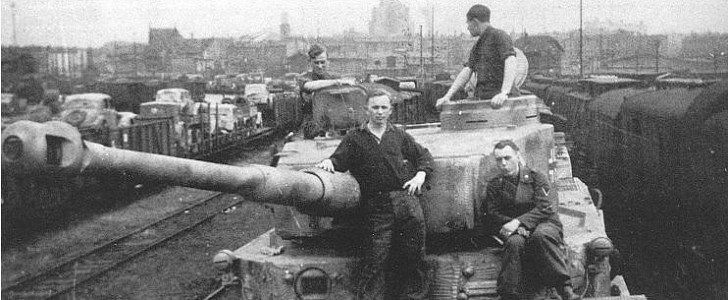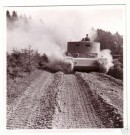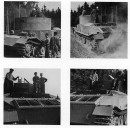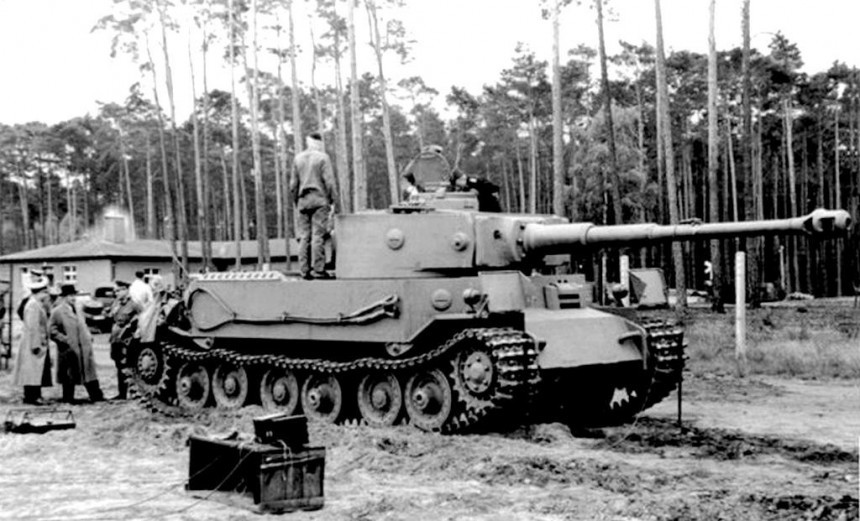Ferdinand Porsche was an eccentric man. A man of many talents, all under the general purview of engineering. But to say that all of his inventions and his machines were built for the betterment of mankind is not entirely accurate. A few of his ideas were used as weapons of war.
Perhaps none were more famous than the VK 45.01(P) Tiger tank prototype. It's been a topic of great debate as to whether or not Old Man Porsche was aware of the slave labor and the appalling conditions of the factories which built his war machines. It's a subject Porsche themselves have investigated as recently as the late 2000s. What is better understood is that the German High Command saw use for Old Man Porsche's eclectic talents for building weapons of war.
What the German Army and Government valued so highly about Ferdinand Porsche's work was his ability to design simple, cheap transportation for the masses. His prior work with Austro-Daimler and on the Mercedes-Benz SS/SSK program was classic proof of this at work. It was all the justification needed to award Porsche military contracts.
It started, of course, with the original Volkswagen Beetle, a car built for civilians and SS officers alike. It's his work on this project that earned Porsche the title of Great German Engineer by the German government. Even if Porsche himself was born in an ethically Czech section of Germany, now indeed part of the Czech Republic. Many in the German government at this time deemed Czechs to be beneath that of ethnic Germans. Still, this blatant hypocrisy didn't stop the Wermacht from awarding Porsche a contract to compete for the rights to build a new German Heavy Tank in May 1941.
Years before Porsche's rivals at Ferrari, Maserati, the Chevy Corvette, and even the 911 sports car itself, Porsche's greatest rival was the team at Henschel & Son Company Kassel, in the German region of Hesse. Both companies were given design contracts for what was to become the Tiger I heavy tank. The design parameters were simple yet endlessly complex. It must be able to house a converted version of the lauded German 88mm anti-aircraft cannon repurposed for tank-to-tank combat. It must also weigh no more or no less than 45 tons, although this metric would soon change to be as high as 60 tons.
Porsche's heavy tank design built for a crew of five was dubbed the VK 45.01P (P, standing for Porsche). It was to be driven by an eclectic powertrain that makes the modern Porsche Taycan's EV drivetrain seem simple, even mundane. It consisted of twin ten-cylinder Porsche Type 101 diesel engines.
Each of these engines would power a separate Siemens-Schuckert 500 kVA generator, which in turn powered twin 230 kW (308.43 hp) generators that powered a series of electric motors that drove either tank tread. Of course, being a Porsche product built before the 996 911, these engines were air-cooled. A trend that the company refused to back away from for decades following the war. Now how's that for a plug-in electric hybrid? Eat your heart out, Chevy Volt.
Considering it would be a full five decades before the ins and outs of hybrid drivetrains would be fully understood, there were teething problems aplenty for Porsche's design. There were even talks that Porsche Tiger I tanks could interfere with the supply chains dedicated to the upkeep of Germany's fleet of diesel-electric U Boats, with copper being an especially prioritized resource. Even so, the Porsche Tiger I was given a fair crack at the competition against its rivals at Henschel.
The competition intended to determine the superior design in the categories of speed, maneuverability, reliability, firepower, and overall structural integrity. Any shortcoming in one of these areas could see one design take a clear advantage over the other. It was here that the Porsche Tiger design began to show some unfortunate flaws. The first one, surprisingly enough, came from the Porsche Tiger's drivetrain. The system required constant maintenance to keep the combination of internal combustion engines and electric motors running trouble-free.
Furthermore, the added electric generators contributed greatly to the overall weight, in excess of 66 short tons and 59 long tons. Meanwhile, the twin Maybach engined Henschel VK 45.01 (H) turned out to be a formidable adversary. It was fast and agile for its size and made great use of the flak-gun-derived main battery.
In the end, Porsche lost the design contest to Henschel, and all remaining Porsche Tiger tank hulls were converted into the Ferdinand Heavy Tank Destroyer, later known as the Elefant. As far as historians can tell, only one prototype Porsche Tiger ever saw combat in the Second World War as a command tank in April 1944. By July of that year, the tank was lost.
So then, if you didn't understand why Porsche is so hesitant to acknowledge its military heritage in the distant past, hopefully now it makes all the sense in the world. Not only did Porsche fail to win the Tiger tank contract, but the Elefant tank destroyers built afterward were hardly game-changers in the war.
We can at least be content with the fact that Ferdinand Porsche was much better suited to building sports cars than he was building war machines. It makes shining Old Man Porsche in a positive light much more palatable. Check back for more from Porsche Month right here on autoevolution.
What the German Army and Government valued so highly about Ferdinand Porsche's work was his ability to design simple, cheap transportation for the masses. His prior work with Austro-Daimler and on the Mercedes-Benz SS/SSK program was classic proof of this at work. It was all the justification needed to award Porsche military contracts.
It started, of course, with the original Volkswagen Beetle, a car built for civilians and SS officers alike. It's his work on this project that earned Porsche the title of Great German Engineer by the German government. Even if Porsche himself was born in an ethically Czech section of Germany, now indeed part of the Czech Republic. Many in the German government at this time deemed Czechs to be beneath that of ethnic Germans. Still, this blatant hypocrisy didn't stop the Wermacht from awarding Porsche a contract to compete for the rights to build a new German Heavy Tank in May 1941.
Years before Porsche's rivals at Ferrari, Maserati, the Chevy Corvette, and even the 911 sports car itself, Porsche's greatest rival was the team at Henschel & Son Company Kassel, in the German region of Hesse. Both companies were given design contracts for what was to become the Tiger I heavy tank. The design parameters were simple yet endlessly complex. It must be able to house a converted version of the lauded German 88mm anti-aircraft cannon repurposed for tank-to-tank combat. It must also weigh no more or no less than 45 tons, although this metric would soon change to be as high as 60 tons.
Each of these engines would power a separate Siemens-Schuckert 500 kVA generator, which in turn powered twin 230 kW (308.43 hp) generators that powered a series of electric motors that drove either tank tread. Of course, being a Porsche product built before the 996 911, these engines were air-cooled. A trend that the company refused to back away from for decades following the war. Now how's that for a plug-in electric hybrid? Eat your heart out, Chevy Volt.
Considering it would be a full five decades before the ins and outs of hybrid drivetrains would be fully understood, there were teething problems aplenty for Porsche's design. There were even talks that Porsche Tiger I tanks could interfere with the supply chains dedicated to the upkeep of Germany's fleet of diesel-electric U Boats, with copper being an especially prioritized resource. Even so, the Porsche Tiger I was given a fair crack at the competition against its rivals at Henschel.
The competition intended to determine the superior design in the categories of speed, maneuverability, reliability, firepower, and overall structural integrity. Any shortcoming in one of these areas could see one design take a clear advantage over the other. It was here that the Porsche Tiger design began to show some unfortunate flaws. The first one, surprisingly enough, came from the Porsche Tiger's drivetrain. The system required constant maintenance to keep the combination of internal combustion engines and electric motors running trouble-free.
In the end, Porsche lost the design contest to Henschel, and all remaining Porsche Tiger tank hulls were converted into the Ferdinand Heavy Tank Destroyer, later known as the Elefant. As far as historians can tell, only one prototype Porsche Tiger ever saw combat in the Second World War as a command tank in April 1944. By July of that year, the tank was lost.
So then, if you didn't understand why Porsche is so hesitant to acknowledge its military heritage in the distant past, hopefully now it makes all the sense in the world. Not only did Porsche fail to win the Tiger tank contract, but the Elefant tank destroyers built afterward were hardly game-changers in the war.
We can at least be content with the fact that Ferdinand Porsche was much better suited to building sports cars than he was building war machines. It makes shining Old Man Porsche in a positive light much more palatable. Check back for more from Porsche Month right here on autoevolution.








